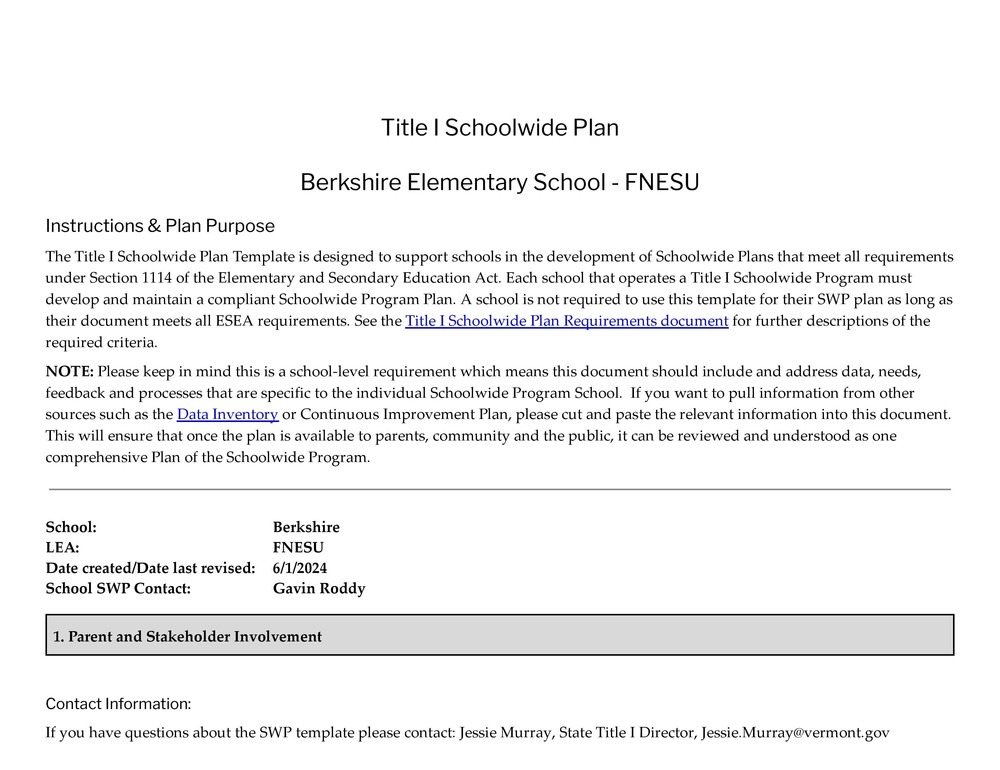Title I Schoolwide Plan
Berkshire Elementary School - FNESU
Instructions & Plan Purpose
The Title I Schoolwide Plan Template is designed to support schools in the development of Schoolwide Plans that meet all requirements under Section 1114 of the Elementary and Secondary Education Act. Each school that operates a Title I Schoolwide Program must develop and maintain a compliant Schoolwide Program Plan. A school is not required to use this template for their SWP plan as long as their document meets all ESEA requirements. See the Title I Schoolwide Plan Requirements document for further descriptions of the required criteria.
NOTE: Please keep in mind this is a school-level requirement which means this document should include and address data, needs, feedback and processes that are specific to the individual Schoolwide Program School. If you want to pull information from other sources such as the Data Inventory or Continuous Improvement Plan, please cut and paste the relevant information into this document. This will ensure that once the plan is available to parents, community and the public, it can be reviewed and understood as one comprehensive Plan of the Schoolwide Program.
School: Berkshire
LEA: FNESU
Date created/Date last revised: 6/1/2024
School SWP Contact: Gavin Roddy
1. Parent and Stakeholder Involvement | ||||||||||||||||||
ESEA Requirement: The plan must be developed with the involvement of parents and other members of the community to be served and individuals who will carry out such plan, including teachers, principals, other school leaders, paraprofessionals present in the school, administrators (including administrators of programs described in other parts of this title), the local educational agency, to the extent feasible, tribes and tribal organizations present in the community, and, if appropriate, specialized instructional support personnel, technical assistance providers, school staff, if the plan relates to a secondary school, students, and other individuals determined by the school (ESEA § 1114(b)(2)). | ||||||||||||||||||
Instructions: Please describe the process used for involving parents and all required members of the school community noted above, in the development of this Schoolwide Program Plan. Include details such as when and what kind of stakeholder involvement did or will take place, who was or will be involved and how the involvement has or will occur. | ||||||||||||||||||
The school held a Title I meeting on Thursday, August 24th at 7:00 A.M. Parents and community members were invited to attend. At the meeting the Title I school wide plan was described and questions and feedback from visitors was provided. The Berkshire Leadership committee met biweekly to continuously review the 2023-2024 schoolwide plan as well as to develop and revise the plan for 2024-2025. During these meetings the team reviewed school data to:
Stakeholders met with the principal on Thursday, May 30th to review the Schoolwide Plan and provide further feedback regarding the plan. Optional Stakeholder Involvement Chart:
If you would like to be added to this school’s SWP Planning Committee, please contact Gavin Roddy. |
2. Comprehensive Needs Assessment |
ESEA Requirement: An eligible school operating a Schoolwide Program shall develop a comprehensive plan that is based on a comprehensive needs assessment of the entire school that takes into account information on the academic achievement of children in relation to the challenging State academic standards, particularly the needs of those children who are failing, or are at-risk of failing, to meet the challenging State academic standards and any other factors as determined by the local educational agency (ESEA § 1114(b)(6)). |
Instructions: Summarize the results of the school’s comprehensive needs assessment, including a description of the data sources used. Please describe specific assessment measures/data results that have been or will be used to identify the school specific needs. Include information regarding the academic achievement of students who are failing or most at risk of failing to meet challenging State academic standards and potential causes. Consider including the summarized analysis of all subgroups defined in ESEA Section 1111(c)(2) (students who are economically-disadvantaged, students from major racial and ethnic groups, children with disabilities, and English learners). |
For Berkshire’s Comprehensive Needs Assessment, we utilized a variety of data sources (student achievement data):
Summary of Data: From a whole school level the data indicates both increased academic and behavioral needs for our students. Because last year was the first year of implementation for the VTCAP and there were numerous reported issues with the implementation, this data lacks a point of comparison and may not be indicative of students’ true abilities. For the STAR literacy assessment, the results showed modest improvement in average scores and number of students at or above the benchmark. Consistent improvement was shown for grades K-2, while 3rd-5th grades showed increased averages but also some slight decreases in the number of students scoring at or above grade level. Middle school students showed either stagnation or slight regression in reading from winter to spring. For math benchmarks, the results were far more indicative of positive growth. There was consistent growth from grades K-5 in both average scores and number of students at or above grade level. 8th grade also demonstrated this growth. 6th grade improved in average score from the start of the year and in number of students at or above grade level from winter to spring. 7th grade served as an anomaly in that there was a decrease both in average score and numbers of students performing at or above grade level. The Fountas and Pinnell assessments indicated both a substantial decrease in numbers of students needing to be assessed while a general increase in averages, indicating an increase for the majority of students in reading proficiency. With that said, that majority of students still remained below grade level in math and reading as indicated by the STAR results. Several explanations include:
The current attendance data indicates a minimal increase in student attendance (going from 90.63% average attendance in 2022-2023 to 90.83% in 2023-2024). In addition to this, family participation in student learning remains stagnant with only an average of 33% of all families choosing to participate in student-led conferences in November and April. Some of the potential causes for this are:
The 2023-2024 data demonstrates an increase in SEL needs for all Berkshire students. This past year there have been 1,759 office discipline referrals. Nearly 600 of these referrals came from 7 students alone. This represents a substantial amount of time that students were out of the classroom due to needing to access members of the behavioral support team. In addition to this, there were 245 state-reportable incidents that required the direct involvement of the principal. This indicates a major need for Berkshire to better align its current behavior management and SEL practices to the current needs of its students. Some of the potential causes for this data are:
|
3. Schoolwide Plan Strategies |
ESEA Requirement: The Schoolwide Plan shall include a description of the strategies that the school will be implementing to address school needs, including a description of how such strategies will –
|
Instructions: Describe the comprehensive strategies that the school will use to upgrade the entire educational program to improve achievement of all students, particularly students most at risk of not meeting challenging State academic standards. Proposed strategies should address all three requirement areas noted above. Please include a specific description of each strategy, the need being addressed and the intended objective. Please note that each strategy should clearly be supported by a data driven need included in the comprehensive needs assessment section 2. |
To address the academic achievement concerns, Berkshire will continue to work to ensure that:
Further Strategies to address concerns in academic proficiency in Math: If:
Then: There will be a 50% increase in the number of students testing at or above grade level in mathematics as evidenced by the VTCAP, STAR assessment, and HLA assessments by the end of the 2024-2025 school year. Further Strategies to address concerns in academic proficiency in ELA: If:
Then: There will be a 50% increase in the number of students reading at or above grade level as evidenced by the VTCAP, STAR assessment, MyView assessments, and Amplify assessments by the end of the 2024-2025 school year. To address social emotional learning, attendance, and student engagement Berkshire will continue to work to ensure:
Further Strategies to address concerns in Social Emotional learning, engagement and to promote a safe and healthy school: If:
Then: The number of office discipline referrals will decrease by 33%, and the number of administrative referrals for state-reportable offenses will decrease by 50% as evidenced through our student referral data by the end of the 2024-2025 school year. |
4. Evaluation and Revision |
ESEA/CFR Requirement: A school operating a Schoolwide Program must-
|
Instructions: Describe how the school evaluates the implementation of, and results achieved by, the Schoolwide Program strategies using data from the State’s annual assessments and other indicators of academic achievement. Include details about how this information is used to revise the Schoolwide Plan annually to ensure program improvement. |
The Berkshire Continual Improvement Team team meets biweekly to review the effectiveness of the Schoolwide Program strategies by analyzing data from various sources including, but not limited to:
The leadership team also collaborates on developing the master schedule to facilitate the various goals and strategies mentioned above including dedicated time for:
Both the Continual Improvement Team and faculty in general regularly review student performance data in content areas and SEL to review if a) students are making progress via universal instruction, b) students are receiving the appropriate / necessary interventions, c) and if those interventions are achieving the desired growth. Lastly the team reviews and discusses if further changes need to be made during the year and/or for next year based on student performance. As mentioned in the previous section, if Berkshire Elementary School effectively implements the strategies outlined, the school should expect to see improvements in our student performance across all demographics, and particularly we should expect to see:
This Schoolwide Program Plan has been regularly monitored using the above described measures to ensure continuous improvement of students. Using the results of these evaluation processes, the Schoolwide Program Plan was most recently revised on 5/30/2024. |
5. Other Requirements |
The school and LEA are responsible for ensuring that all additional requirements under ESEA are met:
|
Instructions: Fill in the appropriate information in the prompts below. If additional information is needed to provide clarity, add any other relevant details regarding the above requirements. |
This plan will be made available to the school community via the school website and in print form. If a language translation or other accommodation needs to be made, please contact Gavin Roddy. This plan is developed in coordination with other federal, state and local services, resources and programs such as the Restorative Justice Center, LEAPS, DCF, and NCSS. This plan is in effect for the 2024-2025 school year. This plan will be monitored throughout the year during biweekly Continual Improvement Team meetings, with specific reviews in the mid fall, mid winter and mid spring. The plan will be revised in the spring to ensure that the plan is based on student needs and is providing opportunities for all students to meet the challenging state academic standards. |

